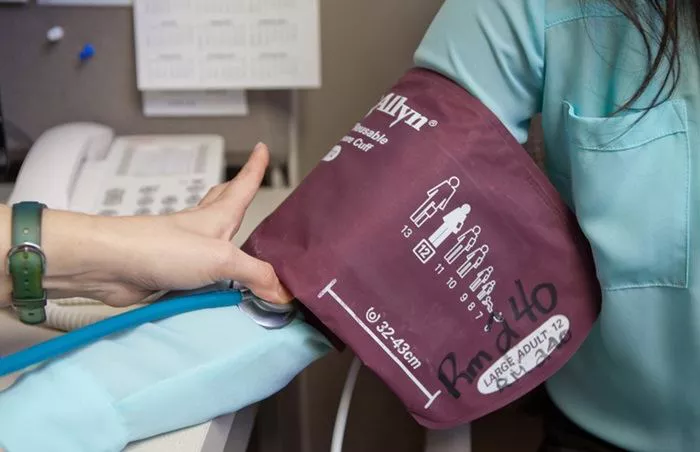The alarming rise of severe high blood pressure during pregnancy is leading to increased complications and maternal deaths in the U.S., despite medical advances. Mary Collins, from Montana, and her daughter Rory are among the survivors of this condition, but their journey reflects a broader crisis facing pregnant women across the country.
Sara McGinnis, nine months pregnant with her second child, felt something was wrong. Her body was swollen, and she experienced dizziness and fatigue. Despite raising her concerns with doctors and even visiting the emergency room, she was dismissed with the reassurance: “It’s summertime and you’re pregnant.”
Two days later, Sara suffered a massive stroke and seizure on her way to the hospital. She never met her newborn son, Owen, who survived through an emergency delivery. Sara died from eclampsia, a condition caused by dangerously high blood pressure in pregnancy, leading to a fatal stroke.
Sara’s story, tragically, is not an isolated case. Instances of dangerously high maternal blood pressure, whether newly developed during pregnancy or chronic, have doubled since 2007. Despite improvements in diagnostic testing, maternal deaths from hypertension-related complications continue to rise, with the U.S. maternal mortality rate climbing overall.
Lowering the Threshold for Action
Medical experts are working to address the crisis. In 2022, the American College of Obstetricians and Gynecologists (ACOG) lowered the threshold for treating high blood pressure in pregnant and postpartum women, a crucial step in preventing complications. Federal agencies have also provided training to healthcare providers, offering best practices for screening and treatment.
States like Alaska and West Virginia have seen declines in maternal deaths related to high blood pressure after implementing these guidelines. However, hospitals across the country are still catching up. According to Annie Glover, senior research scientist with the Montana Perinatal Quality Collaborative, it takes time for hospitals to fully incorporate new standards into routine care.
An Unclear Picture
The causes of preeclampsia and high blood pressure during pregnancy remain unclear, especially for women who do not fit the traditional risk factors, such as being over 35 or overweight. Mary Collins, 31, did not meet these typical criteria, yet her pregnancy was marked by severe complications.
Collins, who maintained an active lifestyle throughout her pregnancy, began experiencing rapid weight gain and slowed fetal growth. After voicing her concerns to her doctor, she was diagnosed with preeclampsia, a life-threatening condition. Collins was airlifted to a larger medical center in Missoula, where her daughter Rory was delivered two months prematurely. Both mother and daughter are still recovering from the ordeal.
The typical treatment for preeclampsia is early delivery of the baby, though in some cases, the condition can develop postpartum, posing additional risks to the mother. Researchers are still trying to understand why preeclampsia continues to strike even after childbirth.
The Importance of Monitoring
“Pregnancy is a natural stress test,” says Dr. Natalie Cameron, a physician and epidemiologist at Northwestern University. Cameron notes that pregnancy often unearths underlying health risks, such as high blood pressure, which could lead to serious complications like heart attacks.
One of the challenges in managing high blood pressure during pregnancy is the inconsistency in symptoms. Emma Trotter, for example, experienced dangerously high blood pressure twice after giving birth. Despite initially being dismissed by medical staff, her second post-delivery episode led to a life-saving intervention. Her care team discovered her blood pressure was so high that the monitoring equipment was initially thought to be malfunctioning.
For Trotter and many other women, consistent monitoring of blood pressure during and after pregnancy is critical. Federal efforts have intensified in recent years, with the Health Resources and Services Administration collaborating with ACOG to promote safer birthing practices and better screening for high blood pressure.
Implementing Life-Saving Practices
In Montana, the Perinatal Quality Collaborative has been providing high blood pressure training to hospitals statewide. The initiative revealed gaps in care, such as inconsistent treatment and monitoring protocols. Bozeman Health, one of the state’s hospital systems, is now working to ensure that any pregnant woman with high blood pressure receives appropriate care within an hour. Warning posters and checklists for preeclampsia symptoms have been distributed throughout hospital clinics and patient areas.
Nurse Katlin Tonkin, who trains healthcare providers in Montana on best practices for maternal care, knows firsthand the devastating effects of preeclampsia. In 2018, Tonkin’s son Dawson died soon after birth due to a lack of oxygen caused by her undiagnosed severe preeclampsia. Despite her heartbreak, Tonkin has since given birth to two healthy sons and continues her mission to improve care for other mothers.
“We have the knowledge and the evidence-based practices,” Tonkin says. “Now, it’s about ensuring they are consistently implemented.”
Looking Ahead
While awareness and monitoring efforts are improving, the rising cases of high blood pressure during pregnancy and related maternal deaths underscore the urgent need for faster action. Doctors and medical staff across the country must continue adopting best practices to reduce risks and ensure that women’s concerns are heard and acted upon.
For Mary Collins, Rory’s early birth may have saved both their lives, but for others like Sara McGinnis, the time for change is already overdue.
[inline_related_posts title=”You Might Be Interested In” title_align=”left” style=”list” number=”6″ align=”none” ids=”11079,9507,9501″ by=”categories” orderby=”rand” order=”DESC” hide_thumb=”no” thumb_right=”no” views=”no” date=”yes” grid_columns=”2″ post_type=”” tax=””]


































